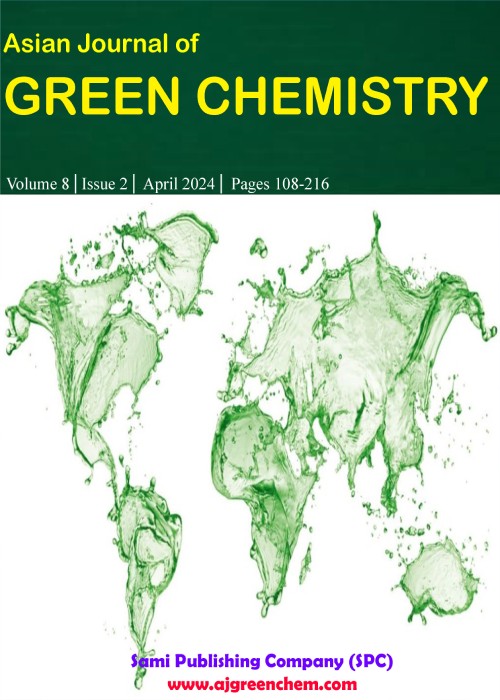فهرست مطالب
Asian Journal of Green Chemistry
Volume:2 Issue: 1, Winter 2018
- تاریخ انتشار: 1396/10/11
- تعداد عناوین: 7
-
Pages 1-10In the present study, a variety of dibenzo [b,f][1,4] oxazepine derivatives was successfully synthesized in good yields under ultrasonic irradiation as an environmental friendly technique. This one-pot method is practically reliable, mild, catalyst-free, and inexpensive. Ultrasonic irradiation on the reaction mixture leads to fine emulsion between the reactants and violent collapses of a lot of cavitation bubbles in less than a microsecond releases extreme heat, leading to cross the activation energy barrier. In the absence of ultrasonic irradiation, a trace amount of the product was formed after 50 min. The superiority of the ultrasound irradiation over other methods in the synthesis of dibenzo [b,f][1,4] oxazepine derivatives is its low reaction temperature and operational simplicity in approximately same yields.Keywords: Dibenzo[b, f][1, 4]oxazepine Ultrasonic irradiation Sonocatalytic ability Catalyst-free reaction
-
Pages 11-24A mixture of two ionic liquids have been used for a green synthesis of 3,4,6-triarylpyridazine in high yield and at room temperature. The two ionic liquids acts in tandem. The advantage of this method is a room temperature synthesis of the target compounds using green methodology. Product recovery is simple and the mixture of ionic liquids can be recovered and recycled.Keywords: Pyridazine, Pyridinium based ionic liquid, Hydrazine, Tetra-n-butyl ammonium hydroxide, Acetophenones
-
Pages 25-40A novel magnetic layered double hydroxide known as Zn0.5Cu0.5 Fe2O4@SiO2@Ni−Cr layered double hydroxide was synthesized with Zn0.5 Cu0.5Fe2O4, SiO2 and Ni−CrLDH by using coprecipitation method. In order to compare the adsorption efficiency, the Ni−CrLDH sample also was synthesized. The synthesized samples were characterized by X−ray diffraction (XRD), scanning electron microscopy (SEM), and Fourier transform infrared spectroscopy (FTIR). The adsorption of Congo red (CR) by magnetic layered double hydroxide depended upon the contact time, initial dye concentration and pH. The adsorption of the Congo red (CR) reached equilibrium at 180 min and followed the pseudo−second−order kinetic equation. The adsorption capacity of the magnetic layered double hydroxide changed significantly between pH 4−10 and the maximum dye removal were 88% for CR. Moreover, the magnetic layered double hydroxide can be quickly separated from the aqueous solution by an external magnet before and after adsorption process. This indicated that the Zn0.5Cu0.5Fe2O4@SiO2@Ni−CrLDH composite was an effective adsorbent for CR dye removal with quick separation. The adsorption performance of the synthesized Zn0.5 Cu0.5Fe2O4, SiO2 and Ni−CrLDH and comparing with Ni−CrLDH show that the Zn0.5Cu0.5Fe2O4@SiO2@Ni−CrLDH can be more efficient than Ni−CrLDH for removal of CR dye.Keywords: Layered double hydroxide, Magnetic separation, Adsorption kinetics, Anionic diazo dye
-
Pages 41-50The green synthesis of nanoparticles is an important branch and a relatively new emerging field in nanotechnology which is easy, environmentally friendly, cost effective, and economically efficient in comparison with the chemical and physical methods. In the present work, for the first time, green synthesis of silver nanoparticles (AgNPs) was carried out by using fructose solution as a reducing agent at room temperature. The silver nanoparticles were characterized by UV-Vis, FTIR, XRD, and TEM analysis. The UV-Vis spectral studies confirmed the surface plasmon resonance of the green synthesized silver nanoparticles. The role of different functional groups in formation of the AgNps was shown by FTIR. X-ray diffraction results confirmed the formation of the the AgNPs and TEM results indicated that the average particle size of the silver nanoparticles was 13.24±8.591 nm.Keywords: Green synthesis, Silver nanoparticles, Fructose, Transmission electron microscopy
-
Synthesis of 3-amino-5-methyl-[1,1'-biaryl]-2,4-dicarbonitriles using ZnFe2O4 magnetic nanoparticlesPages 51-58This work studies an efficient, one-pot pseudo multi-component synthesis of 3-amino-5-methyl-[1, 1'-biaryl]-2, 4-dicarbonitriles. This reaction performed under solvent free conditions in the presence of ZnFe2O4 magnetic nanoparticles. The ZnFe2O4 nanoparticles were prepared by an eco-friendly hydrothermal method using aloe vera plant extract solution. Herein 3-amino-5-methyl-[1, 1'-biaryl]-2, 4-dicarbonitriles were synthesis via a simple reaction between the arylidenmalononitrile, malononitrile and sodium carbonate in ethanol at room temperature in the presence of ZnFe2O4 magnetic nanoparticles. Eco friendly, excellent yields of the product, short reaction time, inexpensive, and readily available starting material are the main advantages of this method.Keywords: Biaryl, Multi-component reaction, Nano ZnFe2O4, Malononitrile, Aloe vera
-
Pages 59-69Fe2O3/VO2/SO3H nanocatalyst is reported for simple, and three-component reaction for the synthesis of spirooxindole derivatives by the reaction of isatin, 1,3-cyclohexadiene and malonitrile in solvent-free condition. The method allows easy construction of a library of spirooxindoles in moderate to good yields. The prepared nanocomposite was characterized using fourier transform infrared spectroscopy (FT-IR), scanning electron microscopy (SEM), x-ray diffraction (XRD) analysis, and energy dispersive x-ray spectroscopy (EDX). The nanocomposite was easily recovered using an external magnet and reused several times without a significant loss of the efficiency.Keywords: Fe2O3, VO2, SO3H Spirooxindole Isatin 1, 3-Cyclohexadiene Malonitrile
-
Pages 70-84Quinolinium dichromate (QDC) and quinolinium chlorochromate (QCC) were studied as efficient reagents for electrophilic aromatic nitration using sodium nitrite and thiocyanation by using ammonium thiocyanate under conventional, ultrasonic and solvent-free microwave assisted conditions. The microwave-assisted protocols exhibited remarkable rate acceleration and offered selective thiocyanation of the aromatic and heteroaromatic compounds with good yields. Addition of anionic (SDS) micelle to the reaction medium afforded considerable rate enhancements, while cationic (CTAB) and nonionic (Tx-100) micelles did not affect the rate noticeably. These protocols have were extended to regioselective thiocyanation of various aromatic compounds. Results were are completely similar to the nitration protocols. However, the reactions revealed comparatively shorter reaction times, and better yields in nitration reactions than in thiocyanation protocols. Catalytic effect of the SDS was attributed to the electrostatic stabilization of the cationic electrophile (NO2+ in nitration, and SCN+ in thiocyanation).Keywords: Quinolinium chlorochromate, Quinolinium dichromate, NaNO2, KHSO4, Nitration, NH4SCN, KHSO4


